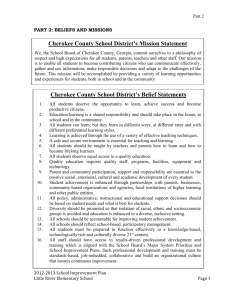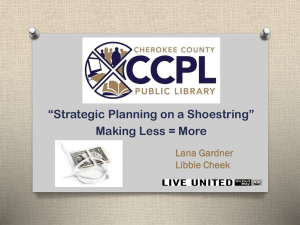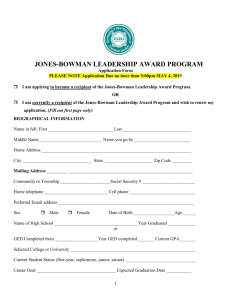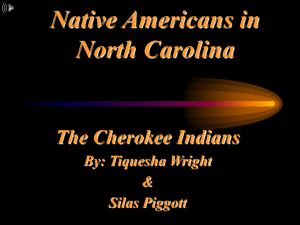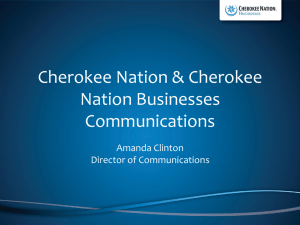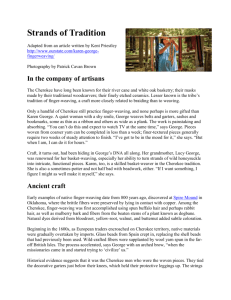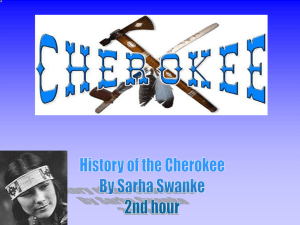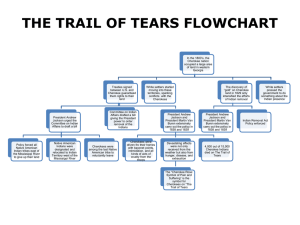Lacee Lambert Dykmann Anthro 1010 – 017 “Final” Though the
advertisement
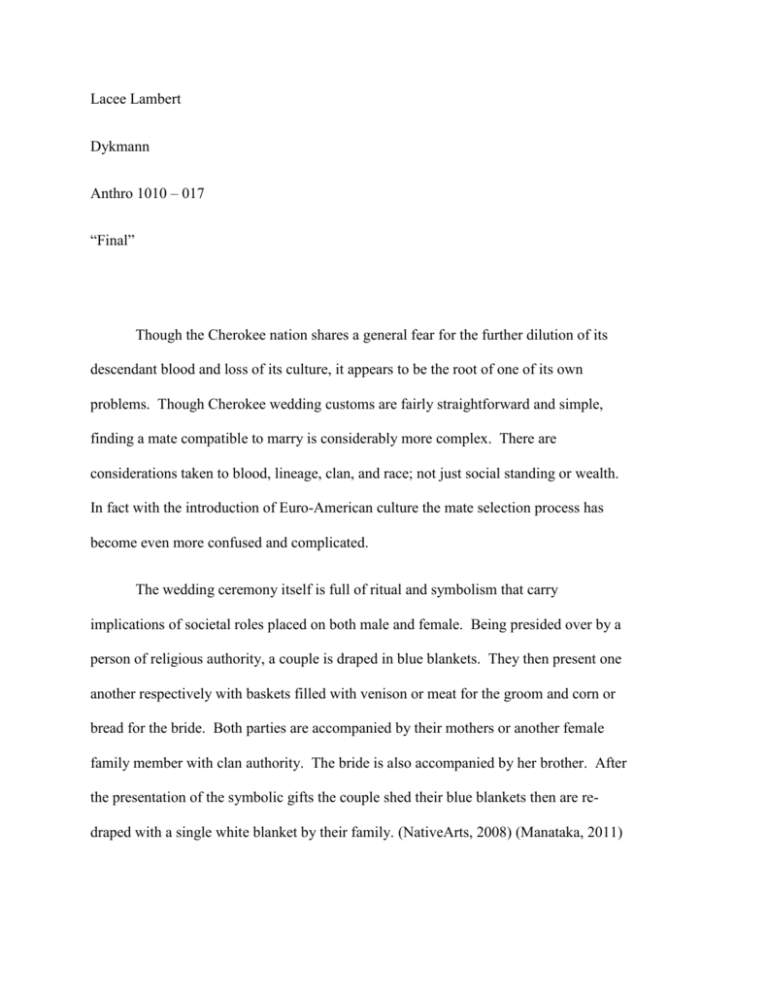
Lacee Lambert Dykmann Anthro 1010 – 017 “Final” Though the Cherokee nation shares a general fear for the further dilution of its descendant blood and loss of its culture, it appears to be the root of one of its own problems. Though Cherokee wedding customs are fairly straightforward and simple, finding a mate compatible to marry is considerably more complex. There are considerations taken to blood, lineage, clan, and race; not just social standing or wealth. In fact with the introduction of Euro-American culture the mate selection process has become even more confused and complicated. The wedding ceremony itself is full of ritual and symbolism that carry implications of societal roles placed on both male and female. Being presided over by a person of religious authority, a couple is draped in blue blankets. They then present one another respectively with baskets filled with venison or meat for the groom and corn or bread for the bride. Both parties are accompanied by their mothers or another female family member with clan authority. The bride is also accompanied by her brother. After the presentation of the symbolic gifts the couple shed their blue blankets then are redraped with a single white blanket by their family. (NativeArts, 2008) (Manataka, 2011) The symbolism behind the ritual of the blankets is to represent the couple shedding, “their old ways of weakness, sorrow, failures and spiritual depression.” (NativeArts, 2008) In putting on the white blanket they are representing the embarking on, “new ways of happiness, fulfillment and peace.” (NativeArts, 2008) This seems to also be symbolic of their union, as they go from two separate blankets to a single blanket to cover them both together. This is not entirely a new idea, as many cultures seem to practice some ritual to represent the union of two separate individuals. (NativeArts, 2008) The food exchanged represents the types of roles expected of the bride and groom respectively in their family as well as society. The groom’s gift of meat is symbolic of his role in providing for his family as a hunter. This prescribed role for the male in the marriage is not only determined by society, but is depicted in legend. The bride’s gift of corn is symbolic of her role in keeping the house, because the bride is literally the holder of properties and the children in the family. It also refers to the traditional role of females in Cherokee society as care takers of the fields and in being held in counsel. (Manataka, 2011) The particular members of the family included in the ceremony also have a symbolic meaning behind it. The mother’s of the bride and groom were present in the wedding party because the women hold the authority of the clan. Because lineage and genealogy are defined typically through the mother’s line and clan in Cherokee society, “Cherokee marriages were as much between the Grandmothers of a clan as between the couple themselves.” (NativeArts, 2008). The bride’s brother is present because he represents the males of her clan. It is the males of a woman’s clan and not the father that are responsible for the education of children. (NativeArts, 2008) (Manataka, 2011) These representative societal roles show a much deeper current in the culture as a whole. These ideals are carried even further in the selection of an eligible mate. Like the roles indicated in the ceremony, roles and restrictions are different for males and females in Cherokee society. Typically males are more restricted in whom they may marry. Traditionally men needed to find a woman not of his clan to marry. This meant that anyone not a part of his matriarchal line or his mother’s clan was an eligible mate. This kind of exogamy was a successful system to maintain tribal and clan integrity. Since the introduction of the Euro-American reckoning of genealogy this clean and clear-cut system has become diluted and confusing. Not to mention a lot more restricting. (NativeArts, 2008) (Strum, 2002) When the tribes started to include the bilateral genealogical system , it suddenly be came taboo to search for mates within both the fathers and the mother’s clan. The pool in which to find a potential spouse became a lot smaller. The Cherokee genealogical definition of a “relative” is anyone that shares your same matrilineal or patrilineal line. Contrasting to the Euro-American definition this includes as many as 10 generations back: Among Cherokees, …blood ties stretch thinner and farther than among Euroamericans. Distant collateral and ascendant relatives who would be long forgotten in U.S. kinship systems are both acknowledged and remembered in Cherokee kinship reckonings. For instance, I recall my amazement when I asked a Cherokee elder about his family history and he proceeded to sketch a detailed family tree dating back to 1710 on the back of a paper napkin. (Sturm, 159) In fact, Circe Sturm quotes many men whose hopes in a potential mate were dashed because a grandmother informed them they were ‘related.’ (Sturm, 2002) The second thing a Cherokee man seeking a mate needs to consider is the purity of a potential mate’s blood. It is said to be that, “Blood can stand for shared biological, racial, or cultural substance, as both Cherokee national identity and individual social identities are manipulated along a race-culture continuum.” (Sturm, 142) This being the case whether a person is half blood or a quarter blood Cherokee can have a huge impact on their eligibility as a potential spouse. According to Sturm, “Cherokee citizens have elected national leaders with increasingly greater degrees of Cherokee blood as the tribal population has become less blooded since the mid-1970s.” (Sturm, 142) A man’s responsibility to his descendants is to secure a higher degree of pure blood status in selecting a mate. (Strum, 2002). The third factor a man must consider is not just the purity of the blood, whether it is “mother’s blood.” For some traditional Cherokees, the lineal source of a person’s blood— whether it derives from the father’s or the mother’s side— can be as meaningful as the amount of that blood, as expressed by blood quantum. (Strum, 153) Due to the importance of matrilineal concept in Cherokee genealogical lines, whether to pureness of the blood come from the mother or the father, can become just as important in some groups on Cherokee society, such as the Keetoowah. Today, many Keetoowahs and other traditional Cherokees maintain that to be a member of a Cherokee clan— some say even to be truly Cherokee— one has to have a Cherokee mother, in other words, to have the blood of a Cherokee mother in one’s veins. (Strum, 154) Again a man’s responsibility to his descendants is to ensure the pureness of their blood status, as well as his responsibility to the tribe by ensuring the blood strength of the tribe stays strong. For example, a middle-aged Cherokee man who was a member of the Keetoowah society told me that before his first marriage “...it wasn’t so important to me that my wife be Cherokee. My ex was onehalf Cherokee. But now, I wouldn’t go below one-half. Mainly, because I want my children to speak the language, to know their culture and to look Indian. I suppose my ideal mate could be one-half, but her Cherokee blood would have to be from her mother, so our child would know its clan. “ (Strum, 154-155) The concept of clan affiliation, not just tribe, is so essential in the Cherokee mindset. It holds more meaning when considering that traditionally one’s clan was one’s mother’s clan. The mother’s clan was responsible for the education and well being of a child. Clan identity ensured the acceptance of a child into Cherokee society. (Strum, 2002) With so much responsibility, it would seem as if the restrictions for females would be as strict in selecting a compatible spouse. This however is not the case. In fact, it seems to be the exact opposite. Speaking from a societal standpoint, the female has less to loose if she marries a spouse with less pure Cherokee blood. She is to a point less restricted in terms of marrying within the bounds of racial endogamy as well. Due to the clash of the ideals that shape one’s search for the ideal mate in Cherokee society, women are more prone to look elsewhere to find a potential spouse. (Strum, 2002) Indeed, a female might restrict the amount of blood status she would be willing to consider in a spouse, out of fear that it limit their social compatibility. …one young Cherokee woman, known as a mixed-blood because she is onequarter Cherokee and a fluent Cherokee-language speaker, said, “I want my husband to be Cherokee, but just part. Not full-blood, because I’m part, not full-blood. I want to marry someone who is part, so my children’s bloodline stays high. It would be good if they were a Cherokee speaker too, but that’s not my main criteria.” (Strum, 153) Due to the matrilineal line and clan concept a woman may also choose to disregard the pressure to choose Cherokee altogether. They feel the tie is still alive through their own blood. A former Cherokee beauty queen, raised in a traditional Cherokee community as a Cherokee Baptist, also noted this important distinction regarding mother’s blood. She said, “Because we are a matrilineal society, the way I look at it, even if I marry a man of another race, our children would still be Cherokee, because I’m Cherokee, and that’s all that matters.” (Strum, 155) Though, women may be freed from much of the obligation that the males feel from the tribe, they still may be victim to familial pressure and obligation. (Strum, 2002) If no suitable marriage candidate can be found, then a Cherokee might seek elsewhere to find a mate. Though tribal exogamy can prove be just as complicated. Cherokees have a socially established racial hierarchy of what is acceptable for marriage. I asked an older Cherokee woman if marrying a Cherokee spouse had been an important consideration in the traditional community where she was raised. She told me bluntly, “It was promoted but not enforced that you marry into the tribe, that you marry a Cherokee. Beyond that you marry white. You don’t marry black people and you don’t marry Mexicans, because Mexicans are in the same class as blacks.” (Strum, 163) Typically Cherokees accept other native American tribes over all other choices. This being that they consider it a mix of cultures rather than a mix of races. The children of such a marriage would still be considered Native American in racially, but would just have to choose what tribal identity they wanted to adopt. If another native American candidate is unavailable then it is considered proper to seek a Caucasian spouse first. As far as exogamous relationships with other races, the Cherokee first consider cultural compatibility then social compatibility. Caucasians racially are considered neutral or it could be said that, “Cherokees tend to see “whiteness” as a culturally and racially “empty” category.” (Strum, 165) Caucasians are also considered to be socially on the same level as Cherokees. Indeed if there is not any other alternative, Cherokees will first marry culturally across then socially up. This in turn strengthens the tribe socially if not in blood purity. The other races are considered to be socially substandard or culturally too full, in eligibility as marriage candidates. The problems with all these various restrictions is that in setting the bar so high on the blood standard and on matrilinealism that your choices are very limited. This confined range of choices almost indefinitely conflict with the exogamy rule of clan. With the induction of the bilateral system, there are now two less clans to choose from. With this genealogical reckoning it, the risk is a Cherokee might be related to most if not all of the available choices. This creates a higher pressure to seek a compatible spouse elsewhere. This in turn further dilutes the strength of Cherokee blood and weakens the strength of the tribe. Once the hurdle of finding a compatible spouse is passed, and wedding vows have been exchanged, being accepted into a family can still be rough. Cherokee parents have high expectations of their Cherokee blooded son and daughter-in-laws: a Cherokee woman in her forties explained how she and her immediate family had a difficult time relating to her first husband. “My family was open to my ex-husband because he was one-quarter Cherokee,” she said, “but he didn’t look Indian and he wasn’t raised the same. He didn’t have the same interests.” So, in spite of his Cherokee ancestry, his phenotypic and cultural differences made it hard for his wife’s family to accept him as kin. “My family knew he wasn’t one of them,” she explained. “He couldn’t be one of us because he didn’t want to. They didn’t feel comfortable around him. In fact they used to tease him… (Strum, 152) Divorce is not entirely frowned upon in Cherokee culture, though divorce cannot be sought after for frivolous reasons. Infidelity is treated especially severely. A divorce request must consult with and acquire the approval by the clan leaders. There is another “blanket” ceremony, referred to as the dividing of the blankets. This is symbolic of the spouses separating and going their separate ways. Since it is the woman who owns the family home and holds a place in the clan, remaining belongings are divided equally and the children remain with her. After approval has been given, a man’s belongings will be placed on a blanket outside the home for him to take with him. (NativeArts, 2008) (Strum, 2002) In conclusion Cherokee marriage customs are varied and very complicated. It would seem that these customs in all their complexity are contradictory in their efforts to re-establish a strong and unified tribe. Whether the adoption and addition of EuroAmerican ideals are the sole cause of this contradiction is another argument entirely. It is clear that the re-establishment of tribal strength and culture is socially paramount, and that this is a chief issue in how a Cherokee chooses whom he or she will marry. Works Cited: “Cherokee Wedding” 2008. Cherokee. AAANativeArts.com. 2008. Web. 6 December 2011 “Cherokee Marriage Customs” 2008. Cherokee. AAANativeArts.com. 2008. Web. 7 December 2011 Sturm, Circe. Blood Politics : Race, Culture, and Identity in the Cherokee Nation of Oklahoma. Ewing, NJ, USA. University of California Press. 2002. Print. 7 December 2011. “The Old Cherokee Wedding” 2011. Manataka American Indian Council. Manataka.com. Web. 7 December 2011.
